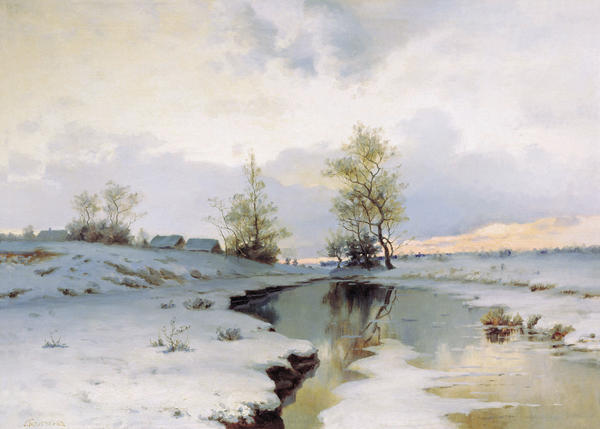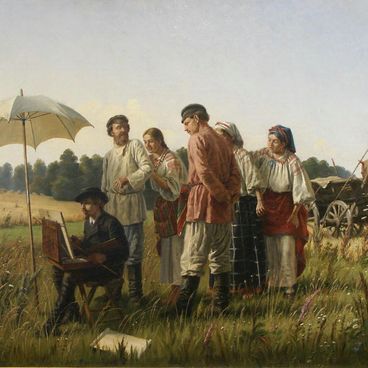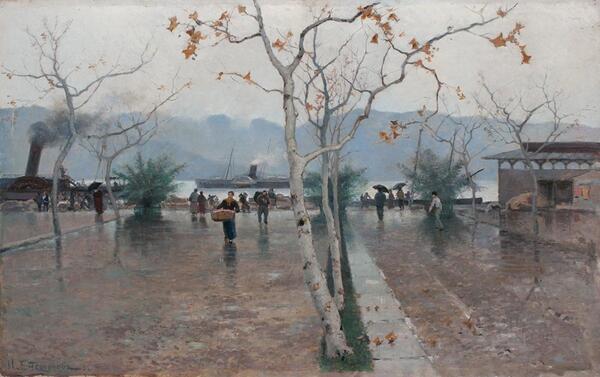Ivan Yendogurov admired the modest beauty of the Russian landscape and found it particularly tender. In each painting the artist tried not just to depict the state of nature, but also to endue its images with human emotions.
Early Spring is different from most of the classical spring landscape paintings of the XIX century saturated with happy anticipation of warmth and the joy of awakening nature. The painting was first introduced to the public in 1898 after the artist’s sudden death. An article published in Pictorial Review magazine pointed out: The foreboding of premature death gave his [Yendogurov’s] landscapes a tranquil and disturbing melancholy.
Sad and cheerful symbols go hand in hand in the painting — it’s a dirty road and green slushy puddles, heavy clouds and the lightening sky on the horizon. However, the gloomy grey colors completely overpower the metaphorical light of hope. So, there is not a single sunray in Early Spring.
The artist was born to the family of Ivan Yendogurov, а naval officer, and his wife Maria. Ivan and his brother Sergey (a future famous watercolorist) got into painting early in their childhood and took private classes from Yefim Volkov, a popular artist at that time. However, after finishing his secondary school, he left for Saint Petersburg to study law.
Only after graduating Ivan Yendogurov decided to fully commit himself to art and entered the Imperial Academy of Arts as an external student. In 1885 he received a minor medal of appreciation for Backyard, A Birch Grove and Early Spring paintings and left the Academy five years later after winning a major medal.
The artist reached his prime creativity period in the 1890s. He worked together with the Itinerants (“Peredvizhniki”) and participated in exhibitions in Paris and Chicago. But, due to progressive pulmonary tuberculosis, Ivan Yendogurov had to spend lots of time in the Crimea and the Caucasus, where he continued painting and created the works like [Crimean Spring and St. George’s Monastery in the Crimea].
Ivan Yendogurov died even before his 37th birthday, but managed to become one of the greatest Russian landscape painters of the XIX century. The Imperial Academy of Arts established one of its most prestigious awards, The Best Landscape Artist, as tribute to the Yendogurov brothers.
Early Spring is different from most of the classical spring landscape paintings of the XIX century saturated with happy anticipation of warmth and the joy of awakening nature. The painting was first introduced to the public in 1898 after the artist’s sudden death. An article published in Pictorial Review magazine pointed out: The foreboding of premature death gave his [Yendogurov’s] landscapes a tranquil and disturbing melancholy.
Sad and cheerful symbols go hand in hand in the painting — it’s a dirty road and green slushy puddles, heavy clouds and the lightening sky on the horizon. However, the gloomy grey colors completely overpower the metaphorical light of hope. So, there is not a single sunray in Early Spring.
The artist was born to the family of Ivan Yendogurov, а naval officer, and his wife Maria. Ivan and his brother Sergey (a future famous watercolorist) got into painting early in their childhood and took private classes from Yefim Volkov, a popular artist at that time. However, after finishing his secondary school, he left for Saint Petersburg to study law.
Only after graduating Ivan Yendogurov decided to fully commit himself to art and entered the Imperial Academy of Arts as an external student. In 1885 he received a minor medal of appreciation for Backyard, A Birch Grove and Early Spring paintings and left the Academy five years later after winning a major medal.
The artist reached his prime creativity period in the 1890s. He worked together with the Itinerants (“Peredvizhniki”) and participated in exhibitions in Paris and Chicago. But, due to progressive pulmonary tuberculosis, Ivan Yendogurov had to spend lots of time in the Crimea and the Caucasus, where he continued painting and created the works like [Crimean Spring and St. George’s Monastery in the Crimea].
Ivan Yendogurov died even before his 37th birthday, but managed to become one of the greatest Russian landscape painters of the XIX century. The Imperial Academy of Arts established one of its most prestigious awards, The Best Landscape Artist, as tribute to the Yendogurov brothers.




